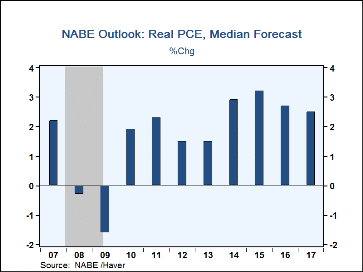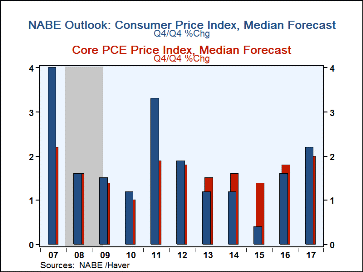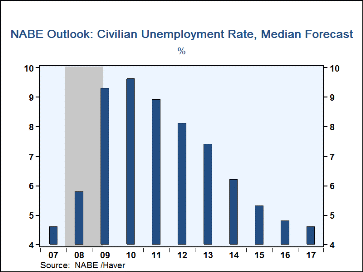 Global| Sep 12 2016
Global| Sep 12 2016NABE Maintains Expectation for Moderate 2017 Economic Growth; 2016 Estimate Reduced
by:Tom Moeller
|in:Economy in Brief
Summary
The National Association for Business Economics held steady its expectation for 2.3% real U.S. economic growth next year. This year's estimate was reduced again, however, to 1.5% from 1.8%, and from 2.6% projected in December. The [...]
The National Association for Business Economics held steady its expectation for 2.3% real U.S. economic growth next year. This year's estimate was reduced again, however, to 1.5% from 1.8%, and from 2.6% projected in December. The gains follow 2.6% growth in 2015 and a 2014 advance of 2.4%. Quarterly GDP growth is expected to range between 2.1% and 2.8%. Growth in personal consumption expenditures is expected to moderate to 2.5% next year following slightly improved estimates of 2.7% growth in 2016 and a 3.2% gain in 2015. Real net exports are expected to deteriorate next year, producing another drag on U.S. GDP growth as import growth of 3.8% outpaces the 2.6% gain in exports. The rate of inventory investment is expected to increase next year versus 2016, but remain below the gains from 2012 to 2015. Growth of 6.1% next year in residential investment was reduced slightly and compares to 11.7% growth in 2015. Government spending growth is projected to be fairly stable at 1.0%, reduced from 1.8% in 2015.
Housing starts are expected to average 1.31 million, slightly less than expected earlier. Expected light vehicle sales of 17.2 million units next year were lessened slightly, but 2016's estimate was unchanged at 17.3 million. Average monthly gains in payroll employment are expected to ease to 168,000 next year versus 192,000 expected earlier. This year's average monthly gain of 185,000 was lessened from 201,000. Expectations for the unemployment rate of 4.6% next year was lessened from 4.7%, while the 2016 estimate held at 4.8%.
Consumer price inflation is expected to average 2.2% next year, unchanged from the last projection. The core PCE price index should rise 2.0% next year, the strongest gain since 2007, and up from the previous expectation of 1.9%. The cost of crude oil is expected to average $52 per barrel next year, up from $47 this year.
The forecasted 2.40% interest rate on 10-year Treasury notes at the end of next year was reduced from 2.73%, and follows a lessened 1.75% estimate at the end of this year. The Fed is expected to continue raising the federal funds rate to a lessened estimate of 1.13% by the end of next year. Corporate profits next year should rise 4.2% following a raised estimate of no-change projected for this year. The Federal government budget deficit is expected to be $526 billion in 2017, roughly one-third its $1.4 trillion peak in 2009.
The figures from the latest NABE report can be found in Haver's SURVEYS database.
The "New Normal" and What It Means for Monetary Policy is the title of today's speech by Fed Governor Lael Brainard and it can be found here.
| National Association For Business Economics | 2017 | 2016 | 2015 | 2014 |
|---|---|---|---|---|
| Real GDP (% Chg. SAAR) | 2.3 | 1.5 | 2.6 | 2.4 |
| Personal Consumption Expenditures | 2.5 | 2.7 | 3.2 | 2.9 |
| Business Fixed Investment | 2.7 | -0.9 | 2.1 | 6.0 |
| Residential Investment | 6.1 | 6.3 | 11.7 | 3.5 |
| Gov't Consumption & Gross Investment | 1.0 | 1.1 | 1.8 | -0.9 |
| Change in Real Business Inventories (Bil. $) | 42.5 | 23.7 | 84.0 | 57.7 |
| Real Net Exports (Bil. $) | -610.0 | -569.0 | -540.0 | -425.7 |
| Housing Starts (Mil. Units) | 1.31 | 1.19 | 1.11 | 1.00 |
| Light Vehicle Sales (Mil. Units) | 17.2 | 17.3 | 17.4 | 16.5 |
| Payroll Employment Average Monthly Change (000s) | 168 | 185 | 229 | 251 |
| Civilian Unemployment Rate (%) | 4.6 | 4.8 | 5.3 | 6.2 |
| Consumer Price Index (Y/Y %) | 2.2 | 1.2 | 0.1 | 1.6 |
| Fed Funds Rate (%, Year-End) | 1.13 | 0.63 | 0.38 | 0.13 |
| 10-Year Treasury Note (%, Year-End) | 2.40 | 1.75 | 2.27 | 2.17 |
Tom Moeller
AuthorMore in Author Profile »Prior to joining Haver Analytics in 2000, Mr. Moeller worked as the Economist at Chancellor Capital Management from 1985 to 1999. There, he developed comprehensive economic forecasts and interpreted economic data for equity and fixed income portfolio managers. Also at Chancellor, Mr. Moeller worked as an equity analyst and was responsible for researching and rating companies in the economically sensitive automobile and housing industries for investment in Chancellor’s equity portfolio. Prior to joining Chancellor, Mr. Moeller was an Economist at Citibank from 1979 to 1984. He also analyzed pricing behavior in the metals industry for the Council on Wage and Price Stability in Washington, D.C. In 1999, Mr. Moeller received the award for most accurate forecast from the Forecasters' Club of New York. From 1990 to 1992 he was President of the New York Association for Business Economists. Mr. Moeller earned an M.B.A. in Finance from Fordham University, where he graduated in 1987. He holds a Bachelor of Arts in Economics from George Washington University.










